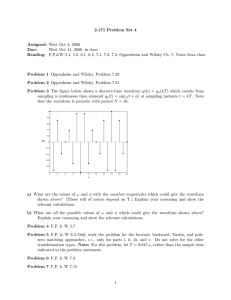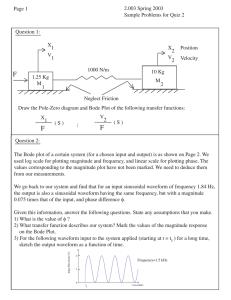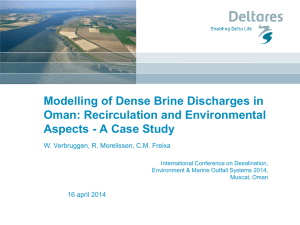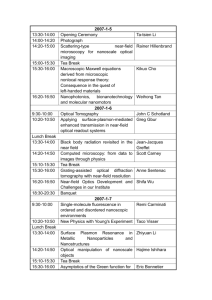Simulation of Cerenkov signal in near-field (PPT)
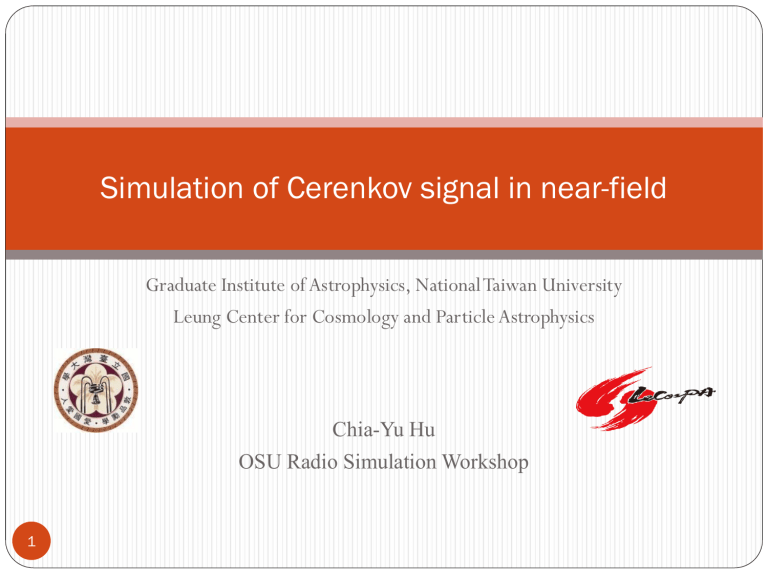
1
Simulation of Cerenkov signal in near-field
Graduate Institute of Astrophysics, National Taiwan University
Leung Center for Cosmology and Particle Astrophysics
Chia-Yu Hu
OSU Radio Simulation Workshop
2
1-D Shower Model
Assuming longitudinal development N(z) with zero lateral width:
Solving retarded time(s): t s t
-
Lorenz gauge t
+
3
1-D Shower Model
Scalar Potential in Near-field: ∵ no signal before t s assuming
4
Single Particle
Infinite particle track, constant velocity (no acceleration), R = 100m
Cherenkov shock
5
Single Particle, finite track q = q c track length = 100 m
R = 100 m R = 500 m
R = 2000m R = 10000 m
6
Single Particle, finite track q = q c
+5 。 track length = 100 m
R = 100 m R = 500 m
R = 2000m R = 10000 m
7
Finite-Difference Time-Domain method
We adopt the finite-difference time-domain technique, a numerical method of EM wave propagation. EM fields are calculated at discrete places on a meshed geometry.
Near field pattern can be produced directly.
z detector
Algorithm:
1) Initializing fields.
2) Calculate E fields on each point by the adjacent H fields.
3) Calculate H fields on each point by the adjacent E fields.
4) Go back to 2) q
R r
8
Maxwell equations in Cylindrical Coordinate
σ m
= 0
H z
= H r
= E
φ
= 0 d/dφ = 0
9
Single Particle in FDTD
Grid size is determined by the smallest length scale (lateral width in our case), in order to prevent from numerical dispersions.
Single point charge will lead to numerical artifacts!
Need to approximate by smooth functions (Gaussian)
10
2D Contour Plot
11
2D Contour Plot
12
2D Contour Plot
13
2D Contour Plot
14
2D Contour Plot
15
2D Contour Plot
16
2D Contour Plot
17
Waveform track length = 4.5 m, R = 1 m
18
Waveform track length = 4.5 m, R = 1.5 m
19
Waveform track length = 4.5 m, R = 2 m
20
Waveform track length = 4.5 m, R = 2.5 m
21
Waveform track length = 4.5 m, R = 5.5 m
Towards more realistic cases
LPM-elongated showers have a stochastic multi-peak structure
(can be viewed as superposition of many sub-showers).
E ~ 10 19 eV
~ 150 m
Squeezing effect greatly enhances part of the shower in near-field, so the potential always shows a sharply rise and smoothly decay (with small oscillations) behavior.
R = 100m
(near-field)
R = 300m R = 1000m
(far-field)
22 sharply rise & slowly decay five-peak structure gradually appears resembles the shower distribution
( no squeezing )
23
Unique Signature in Near-field
Due to the enhancement of squeezing effect, the waveform displays a bipolar & asymmetric feature, regardless of the difference of multi-peak structure from shower to shower.
R = 50m
R = 200m R = 300m
R = 100m
24
Summary
We introduce an alternative calculation of coherent radio pulse based on FDTD method that is suitable in the near-field regime. It is also useful in studying the effect of space-varying index of refraction.
Because of squeezing effect, the Cherenkov waveform in near-field regime presents a generic feature: bipolar and asymmetric , irrespective of the specific variations of the multi-peak structure.
For ground array neutrino detectors (e.g. ARA) where the antenna station spacing is comparable to the typical length of LPM-elongated showers, the near-field effect must come into play.
Detecting the transition from asymmetric bipolar to multi-peak waveform simultaneously provides confident evidence for a success detection.
25
Backup Slides
26
Graphics Processing Unit (GPU)
The FDTD method is highly computational intensive, reasonable efficiency can only be obtained via parallel computing.
We do it on Graphics Processing Unit (GPU), a device particularly suitable for compute-intensive, highly parallel computation.
Compute Unified Device Architecture (CUDA).
* Programmable framework provided by NVIDIA.
* An extension of C language (easy to learn).
A graphic card (NVIDIA GTX280) is capable to give a speed up 10x –
100x comparing with a single CPU.
Performance of GPU Calculation
27
~ 33 hrs ~10 mins
28
Limitations of the FDTD Method
Even with the help of GPUs, the computing resources required by
FDTD still challenge the state-of-the-art devices.
Grid size is determined by the smallest length scale (lateral width in our case), in order to prevent from numerical dispersions.
The ratio of simulation region to grid size is limited by the computer memory.
(at most 8k*8k ~ 1GB)
More sophisticated algorithm has to be implemented (e.g. Adaptive mesh refinement)
Results from FDTD: Waveform
The waveform in near-field generated by full 3-D simulation: bipolar & asymmetric (longitudinal contribution)
29
Asymmetric bipolar waveform in near-field due to the squeezing effect
More and more symmetric as the pulse propagates into the far-field regime
Frequency Domain (Spectrum)
Comparing spectra obtained from FDTD method (solid curves) with that from far-field formula (dashed curves).
(from top to bottom) (from top to bottom)
30
(far-field) (near-field)
The FDTD method reproduces the far-field spectrum and provides correct solutions in near-field.
Distance Dependence
31
Cylindrical behavior
(E w
1/√R ) for small R
Spherical behavior
(E w
1/R ) for large R transition at smaller R
(low freq. mode diffracts more easily)
32
Numerical Dispersion f
= f
0 exp[ i ( kx
wt )] ---- (1)
2
x
2 f
2
x
2 f
V
=
f exp( ik
x ) w
2 c
2
( x f
sin(
2 k
x
( k
2
) x
)
=
c x
0
)
2 f (
---- (4) x )
f (
Phase velocity x
x )
(
x )
2
2
(
x ) 2 exp(
ik
x )
(2) f
= sin
(
2
(
x
2 k
x
)
2
)
2 sin 2 (
(
x
2 k
x
)
2
) 2
w
2 c
2
=
0 f
---- (2)
---- (3)
Numerical dispersion relation
